How To Repair A Rear Main Seal In A 2001 Suzuki Grand Vitara
| Suzuki Vitara | |
|---|---|
 | |
| Overview | |
| Manufacturer | Suzuki |
| Production | 1988–present |
| Body and chassis | |
| Course |
|
| Layout |
|
The Suzuki Vitara is a series of SUVs produced by Suzuki in four generations since 1988. The second and third generation models were known equally the Suzuki Thou Vitara, with the fourth and current series eschewing the "Grand" prefix. In Nippon and a number of other markets, all generations have used the proper noun Suzuki Escudo.
The original series was designed to fill the slot above the Suzuki Jimny. The first generation was known every bit Suzuki Sidekick in the United States. The North American version was produced equally a joint venture between Suzuki and Full general Motors known as CAMI. The Sidekick was sold in various badges such as the Geo Tracker (Chevrolet Tracker beginning 1998 model twelvemonth) in the United states, and every bit the GMC Tracker, Chevrolet Tracker, Asüna Sunrunner and Pontiac Sunrunner in Canada. It was also sold as the Santana 300 and 350 in Spain. In the Japanese market, it was besides sold as the Mazda Proceed Levante.
The 2nd generation was launched in 1998 under the "Chiliad Vitara" badge in well-nigh markets. It was accompanied past a nevertheless larger SUV known as the Suzuki 40-7 (known as Grand Escudo in Nihon). The tertiary generation was launched in 2005.
The fourth generation, released in 2015, reverted to the original name "Vitara" in most markets, but shifted from an off-road SUV towards a more route-oriented crossover mode. It shares the platform and many components with the SX4 S-Cross, a compact crossover in a similar class.[1]
The selection of the name "Vitara" was inspired by the Latin word "vita," as in English language word "vitality."[2] While the "Escudo" proper noun is derived from the "escudo", the budgetary unit of Portugal before adoption of the Euro.
Kickoff generation (ET/TA; 1988) [edit]
| Beginning generation (ET/TA) | |
|---|---|
 Suzuki Sidekick ii-door resin height convertible (US; pre-facelift) | |
| Overview | |
| Also chosen |
|
| Production | 1988–1998 (connected to be produced in Indonesia until 2001 and Spain until 2006) |
| Model years | 1989–1999 |
| Assembly |
|
| Trunk and chassis | |
| Grade | Mini SUV |
| Body mode |
|
| Powertrain | |
| Engine |
|
| Transmission |
|
| Dimensions | |
| Wheelbase |
|
| Length |
|
| Width |
|
| Elevation |
|
| Curb weight |
|

Suzuki Vitara JX 2-door soft top convertible (Commonwealth of australia; pre-facelift)
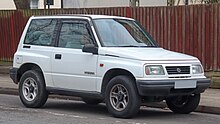
Suzuki Vitara JX 3-door hardtop (United kingdom of great britain and northern ireland; facelift)

Suzuki Vitara JX 5-door (Australia; facelift)
The Suzuki Escudo was kickoff introduced in the Japanese domestic market in July 1988. Northward American Sidekick became available for model year 1989 as a two-door convertible or hardtop. A fuel injected eighty hp (60 kW) 1.6-litre, 8-valve, four-cylinder Suzuki G16A engine was available on the JX and JLX. 1990 brought the deletion of the upscale JLX version. A carburetted version without a catalytic converter was available for some markets; this model produces 75 PS (55 kW) at 5250 rpm.[iv]
In August 1990, the Japanese marketplace received a sixteen-valve G16B engine with 100 PS (73.v kW) as well as an optional four-speed automated.[4] At the same time, the commercial Van version was discontinued. Iii months later a five-door version with a diffuse wheelbase was introduced; it was sold as the "Escudo Nomade" in Japan. Information technology was thought that the v-door would overlap with the shorter 3-door in the marketplace; instead, information technology appealed to a whole new segment and sales in the domestic Japanese market place doubled as a result.[5] 1991 brought the introduction of rear anti-lock brakes. European deliveries of the five-door version began in the summer of 1991.[4]


Suzuki Vitara with longer bumpers, wheel arches, side body mouldings, bigger grille and powered by V6 engine. This model is known as Escudo V6 in Japan, Sidekick Sport in North America or Vitara V6/TD elsewhere.


Japanese market only Mazda Proceed Levante, adopted the V6-engined styling for both three and 5-door torso and iv-cylinder models.
In December 1994, a two.0 V6 (Suzuki's start half-dozen-cylinder) and a two.0-litre Mazda-sourced turbodiesel were added; in return, Mazda got to sell the Escudo in the Japanese market place every bit the Go on Levante with V6 models styling. A diesel fuel selection arrived in Europe in early 1996. In 1996 the Vitara received a facelift, which meant that the V6 was upsized to 2.v-litre while a 2.0-litre iv-cylinder was slotted into the range. In Nihon, the "Nomade" tag was dropped from the 5-door Escudos in Oct 1996. Also for the 1996 model year, Suzuki introduced the Suzuki X-90 which was mechanically identical to the Escudo/Vitara only had a much rounder body, a torso, and removable T-bar roof.[6] The Suzuki X-90 disappeared from Suzuki'southward lineup after the 1998 model twelvemonth. The Sport variant was replaced by the Yard Vitara in 1999.
Strange markets [edit]
N America [edit]
When introduced in 1988, the Sidekick was available with iii trim levels (JA, JX and JLX) and ii engines (ane.three-litre 8-valve Suzuki G13BA engine 64 hp (48 kW) and 1.6-litre viii-valve Suzuki G16A engine 80 hp (sixty kW)). The 1.3-litre engine was just bachelor in JA trim with 2-door convertible trunk fashion.[three] For the 1992 model year a 95 hp (71 kW), one.half dozen-litre, 16-valve Suzuki G16B engine was introduced to the United States. The original Sidekick was updated in 1996 with a new Sport version available with 120 hp (89 kW), ane.8-litre 16-valve iv-cylinder Suzuki J18 engine.[7] The Sport besides had dual airbags, two-tone paint and sixteen-inch blend wheels. 1993 brought an update of the dash in conjunction with the exterior.
-

1996–1998 model of North American Suzuki Sidekick 5-door
-

Pontiac Sunrunner three-door hardtop (Canada)
-

Asüna Sunrunner 2-door resin summit (Canada; front)
-

Asüna Sunrunner two-door resin top (Canada; rear)
-

1992–1994 Geo Tracker 2-door soft top convertible (U.s.a.)
-

1994–1996 Geo Tracker 2-door resin top (Canada)
-

1996–1998 Geo Tracker five-door (US)
-
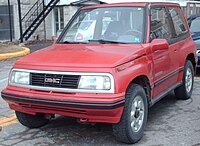
1989–1991 GMC Tracker 3-door hardtop (Canada)
Commonwealth of australia [edit]

Suzuki Vitara Rebel 3-door hardtop (Australia)
In Australia, at that place were ii models available. The Vitara JX and the Vitara JLX. The JLX offered powered windows and trunk-coloured bumpers. Both versions featured the ane.6-litre engine: G16A (carburettor) in the 2-door, G16B (SOHC EFI) in the 4-door, introduced 1992, two-doors got G16B from 1994. In May 1997, Suzuki introduced the 1995 cc J20 2.0-litre 16-valve DOHC engine with both soft meridian and hardtop iii-door models. This engine was rated at 97 kW (130 hp) at 6300 rpm. At the aforementioned time the v-door models received the 1998 cc H20A 2.0-litre V6. Engine power rated for the v-door V6 models was at 100 kW (134 hp) at 6500 rpm. Some of the 1.6-litre variant for the 3-door models were named the Suzuki Vitara Insubordinate. Many pigment or trim or sticker-variants appeared as marketing exercises during the model'due south run in Australia. All models in Australia were sold as four-wheel drives. Early on three-door automatics featured a 3-speed transmission, allegedly derived from a Peugeot unit, which was non equally robust as the later Suzuki-built iv-speed electronic overdrive auto manual. The rear diff on the 1st series Vitara was colloquially-known as "the Japanese 9-inch" as it was a very strong diff and hard to impairment, even with oversized tyres. The front end diffs were less strong, those with the aluminium-cased housing the weakest. The front diff with steel housing was not every bit widely available but is sought after past modifiers.
Republic of indonesia [edit]
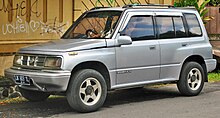

Facelifted Indonesian-built Suzuki Sidekick with different grille and taillights.
In Indonesia Suzuki only sold the 5-door model, kickoff introduced as the Vitara in August 1992.[8] Suzuki launched a 2-wheel drive (rear wheel drive) version labelled as the Escudo in late 1993 to target the urban-driver market and to evade higher taxes on four-cycle-drive vehicles, while the iv-cycle-bulldoze Vitara with 1.half-dozen-litre 8-valve G16A carburettor engine remained bachelor until May 1994. The Suzuki Escudo sales began in early on 1994 as cheaper rear-cycle drive version of Vitara. In April 1995, Suzuki introduced the Sidekick, a lower specification version of the Escudo, as the entry level model. Indonesia is the just market in the world which received all three different names of the Vitra. Later, but 5-door models with the 1.6-litre petrol engine were offered, with no automatic transmission. In early on 1995, the Vitara received a i.6-litre 16-valve G16B engine with fuel-injection arrangement and was marketed as Vitara EPI (Electronic Petrol Injection). However, due to the much higher price that the earlier Vitara, the Vitara EPI sold poorly, discontinued in late 1995 and was later considered a collector item due to its rarity. Too in 1995, the Escudo/Sidekick got a new interior, new front end grille, taillights and some other additional variant chosen Escudo Nomade with two-tone color also introduced subsequently. In 1996, 1.six-litre 16-valve G16B engine was introduced for Escudo/Sidekick range, simply still with carburettor. Some other variant chosen Sidekick Drag Ane was introduced in 1997, this variant was placed between the basic Sidekick and Escudo. Escudo Nomade was axed around 1999, but other models continued to be available until 2001.[eight]
Europe [edit]
The Vitara was an immediate success across Europe. Italia had enacted a law which allowed off-roaders to bypass EEC quotas on Japanese imports, allowing the Vitara to be sold there without limits. In 1988, still, Italian republic'due south Ministry of Foreign Commerce enacted a law requiring "at least one differential lock" for a vehicle to exist considered an off-roader - a requirement non met by the Vitara. Thus, from i January 1989 the Vitara became field of study to the quota in the Italian market place besides, as it was at present classified as a passenger motorcar.[9] In early 1996 European markets began receiving a diesel model.

Santana 300 3-door hardtop (Kingdom of spain)
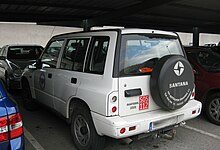
Santana 350 v-door (Kingdom of spain)
Santana Motor built these vehicles and sold them both every bit the Santana 300/350 and as the Suzuki Vitara, to circumvent the EEC quota on Japanese imports. The 300 and 350 have circular headlights and taillights, and is the only version of the machine to accept fog lights fitted in the forepart bumper from mill. The Spanish-built Vitara models, on the other hand, look almost identical to the Japanese-built models, sporting a Suzuki logo in the grille. Steel and paint quality is different between the Castilian and Japanese-built models, both commonly found throughout Europe. Therefore, the Spanish-congenital Vitaras and 300/350s are more prone to rusting in northern European climates than Japanese-congenital counterparts of the same age and mileage. In improver, these vehicles had less insulation than the Japanese ones since they were built for warmer climates. Some of these have also been exported to Southward America. Some of the notable differences between the Japanese and Castilian models are unlike wheels, dissimilar paint schemes and details, unlike side plastic trim, interior details on the Spanish ones in simulated forest, and the VIN code messages.
In the Great britain, two additional body kit models were offered. Some two-door models were sold with an OEM body kit called Wideboy, which had wider wheel arches, sidesteps and 8 inch wide alloy wheels. The Fatboy was also a pop bodykit conversion, offered by the company Suzi Qs, located in Oldbury, Birmingham, UK. The Fatboy converted models had different trim levels, where about sported Cooper Cobra tires, 10 inch wide alloy wheels, different taillights integrated into the rear bumper, in addition to extra styling options like mud flaps, sidesteps, an A-shaped bullbar and auxiliary loftier axle lights.
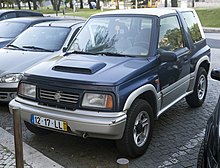
Pre-facelift Suzuki Vitara 3-door hardtop with 1.9-litre turbodiesel engine (Portugal)

Facelifted Suzuki Vitara five-door with ii.0-litre turbodiesel engine (Italy)
The Suzuki Vitara Commercial was available in the United kingdom. It was a Santana-built iii-door tintop Vitara panel van, with no rear windows. The Vitara Commercial had the JX one.nine TD trim level, and sported a Peugeot XUD9 1.ix-litre diesel engine. In 1999, the 1.ix-litre diesel engine was replaced by more than mod ii.0-litre DW10 HDi turbodiesel engine.
In Norway, a modified version of the 5-door version with a taller glass fibre roof were sold with light-green van registration plates to featherbed some tax laws. These models had no rear seats and a grille separating the forepart seats and the rear compartment. In add-on, these had longitudinal roof runway and special custom made, removable transverse roof bars.[ten] Normal roof racks intended to be mounted in the raingutters do fit on the longitudinal rails, just practice stand taller than normal raingutter mounted ones. Many of these were later converted to 5-seat passenger cars with normal white registration plates.[eleven] All Vitaras sold in Kingdom of norway (and other Scandinavian countries) were modified to take the depression beams automatically turn on with the engine running, similarly to DRLs on the CAMI versions of the motorcar.
Another modified version of the 5-door was bachelor in the Netherlands. Information technology was a van similarly to the Norwegian 1, simply had a dissimilar glass fibre roof replacement.
Official product for this generation ended in 2006 with the end of the Santana 300/350.


Vitara Philippe Cousteaux Limited Edition (Frg)
At that place is also a very limited edition named Vitara Philippe Cousteaux which came in metallic pink or cyan with cream leather interior, wooden steering wheel, new wheels, bullbar and several other changes.[12] Merely 500 of this model were produced for European market place. At that place are likewise similar limited editions for British market, but called Rossini (pink) and Verdi (cyan) with different wheels.[13] [14] These limited editions are but available in two-door body style with a i.6-litre 8-valve petrol engine.
Second generation (FT/GT; 1998) [edit]
| Second generation (FT/GT) | |
|---|---|
 1998–2000 Suzuki Grand Vitara v-door (US) | |
| Overview | |
| Also called |
|
| Production | 1998–2005 |
| Model years | 1999–2005 |
| Associates |
|
| Body and chassis | |
| Class |
|
| Torso style |
|
| Related | Suzuki Twoscore-7 |
| Powertrain | |
| Engine |
|
| Manual |
|
| Dimensions | |
| Wheelbase |
|
| Length |
|
| Width |
|
| Height | 1,685–1,740 mm (66.iii–68.5 in) |
| Curb weight | 3-door:
|
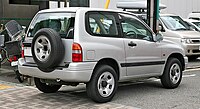
1997–2000 Suzuki Escudo 3-door (Nihon)

2000–2005 Suzuki M Vitara 2-door soft top convertible (Europe)
Suzuki announced the 2nd generation model in November 1997.[15] Slightly larger, more than expensive, and more powerful, information technology used a light-duty automobile-type rack-and-pinion steering box instead of the recirculating brawl truck unit used in the beginning generation. The iii-door version remained in the mini SUV form while the v-door version moved upward to a compact SUV. In almost international markets the name "Grand Vitara" was adopted. In many markets it was originally merely bachelor with larger (two litres and up) engines while the before Vitara was yet bachelor with smaller engines. In the United Kingdom, a 1.6-litre One thousand Vitara (the GV1600) arrived in early 2001.[sixteen]


2000–2005 Suzuki Escudo v-door (Japan)



1997–2000 Mazda Proceed Levante (Japan)
The Vitara connected using Escudo name in Japan and Indonesia. Mazda also continued selling rebadged Escudo in Japan as Proceed Levante until 2000 when information technology was replaced by Mazda Tribute.

2000–2002 Suzuki Vitara ii-door soft top convertible (Canada)

2002–2003 Suzuki Vitara 5-door (Canada)

2002–2005 Suzuki Grand Vitara TD 5-door (United Kingdom)

2004–2005 Suzuki Grand Vitara 5-door (U.s.a.)
It received its facelift in 2000, 2002 and again in 2004. As of 2003, the smaller Suzuki Vitara has been withdrawn from the North American market place. Sales were ho-hum, with merely 4,860 sold in 2004 for the Us. In Canada, sales were strong. All Due north American Vitaras were built at CAMI Automotive in Ingersoll, Ontario and in the Riverside facilities. The soft-top was only congenital in N America, with European consign models assembled in Canada. The three-door railroad vehicle was brought in from Nihon for European buyers and sold alongside the Canadian-made convertibles.[16] The 2001 model Suzuki Grand Vitara comes standard as a 2.0-litre 4WD vehicle in New Zealand.
Grand Escudo [edit]
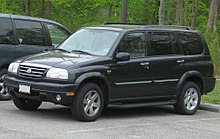
In 1998, The Grand Escudo arrived, a longer, slightly larger, pricier and more powerful version of the regular 5-door. The Japanese market G Escudo was sold in North America and Chile as the Suzuki XL-7. In Australia, Europe and India it was marketed every bit the Grand Vitara XL-7. In Indonesia, information technology was sold as K Escudo 40-seven.
Chevrolet Tracker [edit]
![]()
Chevrolet Tracker (United mexican states)
A rebadged version was sold in N America by General Motors as the Chevrolet Tracker. The Tracker is sold in Latin America - excluding United mexican states - as Chevrolet Grand Vitara. In Mexico, Grand Vitara and Tracker are different vehicles, sold by Suzuki and Chevrolet respectively. In Republic of chile, the v-door G Vitara was known as 1000 Nomade.
Third generation (JT; 2005) [edit]
| Third generation (JT) | |
|---|---|
 Suzuki Chiliad Vitara (2005–2008) | |
| Overview | |
| Also called |
|
| Production | 2005–2017 (extended product continued for some markets until 2019) |
| Associates |
|
| Body and chassis | |
| Class | Compact SUV |
| Trunk style | three and 5-door SUV |
| Powertrain | |
| Engine |
|
| Transmission |
|
| Dimensions | |
| Wheelbase |
|
| Length |
|
| Width | 1,810 mm (71.3 in) |
| Height | ane,695 mm (66.7 in) |
| Curb weight | 1,420–1,710 kg (3,130.6–3,769.9 lb) |
| Chronology | |
| Successor | Suzuki Beyond (Europe) |

3-door SUV

five-door SUV

Interior
An all new redesigned M Vitara (called Escudo in Nippon or G Nomade in Chile) was introduced for the 2005 model year. The third generation received significant changes over the outgoing model. The ladder-frame construction was replaced with unibody construction which featured a unique built-in ladder frame to improve stiffness and basis clearance while also reducing the floor top.[18] The outgoing model'due south forepart MacPherson strut suspension was retained while the rear solid axle was replaced with a fully independent multi-link intermission.[19] Depending on the marketplace, engine options included a 1.6L inline 4 (125 hp), two.0L inline four (156 hp), 2.7L V6 (185 hp) and a 1.9L Renault-sourced diesel engine (127 hp).[20] [xix]
The engine and manual are longitudinally mounted dissimilar most front-bicycle drive based meaty SUVs in its grade. Engines are available with either a five-speed manual or 5-speed automatic transmission. The Grand Vitara is available in both rear-wheel bulldoze merely models (for the Australian market) or with a 4-mode all-wheel drive system.[21] [22]
The nigh widely available Escudo is the 5-door version, but a 3-door version is as well available in some markets such as in Japan, Australia, (parts of the) Middle East, New Zealand and (most of) Due south America. In some markets the three-door variant drops the "Grand" to be branded simply "Vitara". In some countries, including Chile the 5-door version is named "1000 Nomade".
A commonly held misconception is that the third generation Grand Vitara is related to the GM Theta platform. The two are completely unrelated and were developed separately past GM and Suzuki and share no components.
The 1.6 L M16A I4 (petrol) is bachelor in the Base-spec 3-Door version in Japan, Bolivia, Chile, Colombia, State of kuwait, Peru, Qatar and Saudi arabia. The Base of operations-spec five-Door also has this engine in El salvador. This engine is simply available in conjunction with a 5-Speed Manual.
The two.0 L J20A I4 (petrol) is bachelor in the Base of operations-spec 3-Door form in Uruguay. The Base-spec 5-Door version as well has this engine in Bolivia, Burkina Faso, Cameroon, Central African Commonwealth, Chad, Congo, Democratic Republic of Congo, Ecuador, Equatorial Republic of guinea, Gabonese republic, Gambia, Ghana, Republic of guinea, Guinea-Bissau, Indonesia, Madagascar, Malawi, Mali, Mauritania, Niger, Qatar, São Tomé and Príncipe, Senegal and Uruguay. This engine is only available with a v-Speed Manual except for Bolivia and Qatar, where the iv×four two.0 has a 4-Speed Automatic Transmission available. In People's republic of bangladesh, this is the only engine bachelor (in conjunction with a 4-Speed Automatic and a five-Door body).
2008–2011 [edit]

Suzuki M Vitara (2008–2011)

Suzuki Escudo Salomon Limited
In the second half of 2008, the Suzuki Grand Vitara was given a facelift and two new engines. A Suzuki two.4L inline four is offered producing 124 kW (169 PS; 166 hp) of power and 221 N⋅m (163 lb⋅ft) of torque. The previous ii.7L Suzuki V6 is replaced with a GM-sourced three.2L V6. The V6 is only offered in the flagship prestige model which produces 172 kW (234 PS; 231 hp) of power and 289 N⋅m (213 lb⋅ft) of torque. Fuel economic system has besides been improved with the add-on of VVT to both engines and the 1.9L Turbo-Diesel has also received some mechanical piece of work improving its economic system. Safety has as well been improved with more air-bags and traction control existence standard on all models. The iv mode 4-wheel-drive arrangement is too bachelor on all models. It features a lockable central differential along with depression ratio gears. Subtle improvements were made on the exterior of the motorcar such as indicators in the door mirrors and a more pronounced front grille and bumper. The interior also saw a lot of more aesthetically pleasing changes.
The 2.4 50 J24B l4 (petrol) is available in all countries where it is sold (except for Bangladesh). It is also the only engine bachelor in some markets. In Burkina Faso, Republic of cameroon, Primal Africa Republic, Chad, Congo, Autonomous Democracy of Congo, Equatorial guinea, Gabon, Gambia, Ghana, Guinea, India, Jordan, Lebanon, Madagascar, Malawi, Mali, Mauritania, Niger, Oman, São Tomé and Príncipe, Senegal, South Africa, Tanzania and the United Arab Emirates, this engine is simply offered in conjunction with a 4-Speed Automatic or a five-speed manual for India.
2012–2019 [edit]
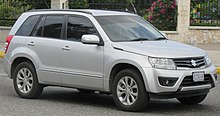
Suzuki Grand Vitara (2012–2019)
In the 2nd quarter of 2012 for the 2013 model year, Suzuki unveiled a facelift Escudo with new wheels, a new grille and front lights. The V6 engine was discontinued from here on. Starting with this facelift, the 1000 Vitara in Indonesia is now a rebadged Escudo, imported from Japan.
Discontinuation [edit]
Suzuki officially discontinued the 3rd generation Escudo in Japan in April 2017 (yet information technology would continue in product for export). In Republic of indonesia, the 3rd generation Grand Vitara was discontinued in 2018. Information technology was too no longer available in Europe, CIS countries and Southeast Asia. It was no longer listed on the Suzuki Philippines website, as of Jan 2019, indicating that it was no longer bachelor.[23] In Islamic republic of iran, information technology was discontinued in July 2019 due to the shortage of CKD parts in Iran Khodro's facilities, low sales, and the political tensions and sanctions.
As of July 2019, the Thousand Vitara was removed from the Suzuki Australia website and it had been withdrawn from auction, and in South Africa, it was officially discontinued in October 2019 with sales well into 2020.
4th generation (LY; 2015) [edit]
| Fourth generation (LY) | |
|---|---|
 Suzuki Vitara (pre-facelift) | |
| Overview | |
| Too called | Suzuki Escudo (Japan) |
| Product | March 2015 – present |
| Associates |
|
| Designer | Kosei Iwasaki, Toshinobu Ishida, Kanae Ito, Kazuhisa Takayanagi and Yoshitaka Uchiyama[24] |
| Trunk and chassis | |
| Form | Subcompact crossover SUV |
| Body way | 5-door SUV |
| Related |
|
| Powertrain | |
| Engine |
|
| Electrical motor |
|
| Transmission |
|
| Hybrid drivetrain |
|
| Battery | Lithium Ion |
| Dimensions | |
| Wheelbase | two,500 mm (98.4 in) |
| Length | 4,175 mm (164.4 in) |
| Width | ane,775 mm (69.nine in) |
| Height | 1,610 mm (63.4 in) |
| Curb weight | 1,075–one,338 kg (ii,370.0–2,949.8 lb) |
The fourth generation Vitara was presented start equally "four-four concept" at 65th IAA Frankfurt Motor Show in September 2013.[25] The production model was unveiled at the 2014 Paris Motor Prove.[26] Its production (by Magyar Suzuki) started in March 2015[27] and parallels with the 3rd generation in Nippon until 2019. The Vitara went on sale in Japan as the quaternary generation Suzuki Escudo on 15 October 2015.[28]
Unlike the previous generations, the all-new fourth generation model was inverse from the traditional ladder frame SUV platform to a lightweight unibody platform, shared with SX4 South-Cross. The engine position and layout also inverse from longitudinal rear-wheel drive/all-wheel drive layout to transverse front-bike drive/all-bicycle drive layout. Information technology is now a subcompact crossover SUV, with 140 mm (5.v in) shorter wheelbase, 325 mm (12.eight in) shorter torso, 85 mm (3.3 in) lower and 35 mm (1.iv in) narrower than the previous generation Grand Vitara, making the Vitara easier to drive on narrow roads and tight parking spaces.[29] [30] This new generation of One thousand Vitara features a 5-speed transmission transmission for the 1.6-litre petrol engine and a 6-speed manual transmission for the 1.half dozen-litre diesel engine. A 6-speed automatic transmission with paddle shifters is also bachelor for the 1.vi-litre petrol engine.[31] [32] It has a luggage space of 289–375-litre (VDA), expanding to 1160-litre with rear seats folded.[33]
Suzuki released a special version of the quaternary generation Vitara called the Vitara Due south or Vitara Sport in some markets. The Vitara S features a 1.4-litre turbocharged petrol engine "K14C Boosterjet", which delivers 140 PS (103 kW; 138 bhp) and 220 N⋅m (162 lb⋅ft), twenty percent more power and xl pct more torque over the standard one.vi-litre petrol engine. The engine, shared with the Suzuki SX4 Southward-Cross facelift 2017, is paired to a vi-speed automatic transmission as standard. It was first available in 4WD "AllGrip" only until summer 2016 and after that again since 2017; starting with autumn 2016 the 2WD arrangement is available for the Southward variant. The Vitara Due south also comes with several cosmetic changes over other Vitara trim levels including leather/suede sports seats with scarlet stitching, aluminum sports pedals, blood-red LED headlamp surrounds, distinctive five-slotted grille and blackness blend wheels.
-

Rear view
-
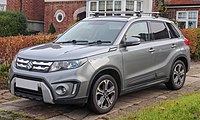
Vitara Rugged Pack
-

Vitara Urban Pack
-

Vitara S
-

Interior
-

Front view of iv-4 concept
-

Rear view of iV-iv concept
-

The 1.6-litre M16A petrol engine
Facelift [edit]
Suzuki unveiled a renewed version of the Vitara at the 2018 Paris Motor Show[34] [35] in milestone of its 30th anniversary in 2018.[36] [37] Changes include a heightened front end bumper to give space for the millimeter-wave radar at the front. The conventional digital multi-data display was replaced with a iv.2" colour LCD MID. Like the Jimny and Swift, Suzuki Safety Support was besides adopted for the model which includes a collision abstention system (Dual Sensor Brake Support) and a traffic sign recognition role.
Starting from 2020, all engine for European market place Vitara was replaced by a new Euro 6d compliant 1.4-litre Boosterjet petrol engine with a 48V mild hybrid engineering science using belt-driven Integrated Starter Generator (ISG), which delivers 129 PS (95 kW; 127 bhp) and 235 Northward⋅grand (173 lb⋅ft). The ISG electric motor produces fourteen PS (ten kW; 14 bhp) and 53 N⋅m (39 lb⋅ft).
In January 2022, Suzuki silently released strong hybrid variant of Vitara in selected countries in Europe such as Republic of hungary, France, Poland and Kingdom of the netherlands.[38] [39] It is powered with a new 1.5-litre petrol dual injector engine called "K15C Dualjet", the reworked version of "K15B" engine that seen in Jimny Sierra or Ertiga. The engine is combined with a Motor Generator Unit (MGU) electric motor, which produces 33 PS (24 kW; 33 bhp) and 60 Northward⋅m (44 lb⋅ft). The combined power of the petrol engine and the electric motor is 115 PS (85 kW; 113 bhp).[39] This hybrid model is only available with a 6-speed automated manual (dubbed as Auto Gear Shift (AGS) by Suzuki) and available for both forepart-bicycle and all-cycle drive configuration.
-
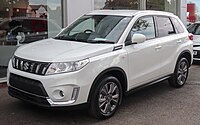
2018 Vitara facelift
-
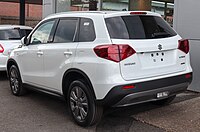
2018 Vitara facelift
-

Vitara Rugged Pack facelift
-
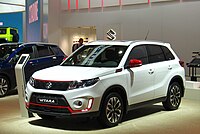
Vitara Urban Pack facelift
-

Interior
Limited and special editions [edit]
In Baronial 2018, Changan Suzuki launched a special edition Vitara called "Star Edition (星耀版)" for Chinese marketplace. Information technology comes with rose aureate colored body, headlights, interior and new grille design. It is only available with 1.4-litre turbocharged petrol engine.[40] [41]
A express edition called "Vitara Katana" was introduced for Italian market place in November 2019. This express edition Vitara pays tribute to the new Suzuki Katana g sport bike. Information technology is based on the ane.0-litre Boosterjet model with transmission manual and tin be ordered with front-wheel bulldoze, or with the renowned Suzuki AllGrip all-wheel bulldoze sistem.[42] Austrian market place also received similar limited edition in September 2020, but based on the ane.four-litre Boosterjet hybrid AllGrip model.[43] [44] Both bachelor in Metallic Silverish or Black colors and limited to 100 units.
A limited edition was made specifically for Mexico named "Cristal" in October 2019. It is only limited to 290 units.[45]
In Japan, a special edition for Escudo called "S Limited" was appear in Nov 2020.[46] This special edition has like concept similar the Chinese market Vitara Stars Edition, but with brown colored headlights, interior, wheels and argent stainless steel pedal.[47]
Limited edition of Vitara Hybrid called "Style" with Urban Pack accessories and an extended 5-twelvemonth or 150.000 km warranty was appear in Apr 2021 for Czech Republic. It is limited only to 200 units.[48]
Sales [edit]
| Calendar Yr | Europe[49] | China[50] | Mexico | Australia |
|---|---|---|---|---|
| 2015 | 43,247 | 4,450 | ||
| 2016 | 73,099 | 41,175 | ||
| 2017 | 72,301 | 27,305 | ||
| 2018 | 67,801 | xiii,222 | ||
| 2019 | 81,860 | iii,717 | six,632[51] | 5,253[52] |
| 2020 | 43,727 | 103 | iv,681[53] | 4,332[54] |
| 2021 | 57,436 | 3,513[55] | 3,742[56] |
Safety [edit]
| Euro NCAP 2015 Suzuki Vitara [57] | |
| Euro NCAP Safety Rating | |
| Developed Occupant | 89% |
| Child Occupant | 85% |
| Pedestrian | 76% |
| Safety Assists | 75% |
| ANCAP 2015 Suzuki Vitara [58] | |
| ANCAP Safety Rating | |
| Frontal First | 14.79/16 |
| Side Touch on | 16.00/sixteen |
| Pole | two/2 |
| Whiplash Protection | Good |
| Pedestrian Protection | Good |
| ESC | Standard |
| Seat Belt Reminders | three.0/three |
| Overall Score | 35.79/37 |
| Rating Year/Datestamp: | 2015 |
| Airbags | Dual Frontal, Side, Head, Knee |
Motorsports [edit]

The V6 Escudo, which between 1996 and 2000 finished runner-upwards at Pikes Summit three times and won at Queenstown 3 times.

In 1994, Suzuki built a twin-engined Escudo to compete in hillclimbing. It featured two heavily modified turbocharged 1.6-litre G16B (with G13B DOHC cylinder head) inline-iv engines – ane at the front end driving the front wheels and one at the rear driving the rear wheels – with a combined power output of 900 PS (662 kW; 888 hp). The car had a adjourn weight of 900 kg (1,984 lb).[59] Driven by Nobuhiro "Monster" Tajima, it finished fifth overall at the Pikes Height International Hill Climb in 1994 and won the event outright in 1995, making Tajima the first Japanese driver to win the event.[lx]
For 1996, Suzuki produced a new Escudo for hillclimbing which had a single twin-turbocharged 2.0-litre H20A V6 engine with a power output of 600 PS (441 kW; 592 hp) and 70 kg⋅one thousand (686 N⋅m; 506 lb⋅ft) of torque for the prototype version,[61] the racing version has college power output, produces 800 PS (588 kW; 789 hp) and 80 kg⋅yard (785 Due north⋅m; 579 lb⋅ft).[62] [63] In 1997, Suzuki upgraded the Escudo with a bigger ii.five-litre H25A V6 engine with a power output of 995 PS (981 hp; 732 kW) at 8100 rpm and 95 kg⋅grand (932 N⋅grand; 687 lb⋅ft).[64] It had 4-wheel drive and weighed 800 kg (1,764 lb).[64] For 1998, the engine was replaced by twin-turbocharged 2.7-litre H27A V6 engine with the same 995 PS (981 hp; 732 kW) power output every bit the previous 2.five-litre engine.[65] Once more, driven by Nobuhiro Tajima, information technology finished second overall at Pikes Peak in 1996, 1998 and 1999, and won the Queenstown Gold Rush International Loma Climb outright in 1998, 1999 and 2000.[60]
A newer Escudo went on to win at Pikes Acme in 2006 and at Queenstown in 2004, 2005, 2006 and 2007.[60]


Suzuki Vitara too participated in numerous cantankerous land rally events effectually the world since the beginning generation, such as Dakar Rally, Australasian Safari, Asia Cross Country Rally and Transsyberia rally.[66]
References [edit]
- ^ "Suzuki Sidekick-Vitara review". About Cars Reviews. 14 April 2016. Archived from the original on 23 August 2019. Retrieved 23 August 2019.
- ^ "Same Car, Unlike Name". www.globalsuzuki.com . Retrieved viii May 2021.
- ^ a b "1989 Suzuki Sidekick Dealer Sales Brochure Large 4X4 Features Options Specs". Machine Paper. Archived from the original on 9 May 2021.
- ^ a b c Büschi, Hans-Ulrich, ed. (5 March 1992). Automobil Revue 1992 (in German and French). Vol. 87. Berne, Switzerland: Hallwag AG. p. 537. ISBNiii-444-00539-iii.
- ^ Anderson, Donn, ed. (April 1993). "Making more than out of small cars". New Zealand Auto. Vol. 7, no. 17. Auckland, New Zealand: Accent Publishing Cnr. p. 8. ISSN 0113-0196.
- ^ Asia Spy Written report, Popular Mechanics, July 1995, p. 29
- ^ "1990-98 Suzuki Sidekick", Consumer Guide Automotive, Publications International, Ltd., six November 2014, retrieved v April 2018
- ^ a b Alfan, Charis (16 June 2016). "Suzuki Vitara, Escudo dan Sidekick SB416". Mobil Motor Lama (in Indonesian). Archived from the original on 8 May 2017.
- ^ Mastrostefano, Raffaele, ed. (January 1989). "Il ministero blocca la Suzuki "Vitara"" [The ministry building blocks the Suzuki Vitara]. Quattroruote (in Italian). Vol. 34, no. 399. Milan, Italy: Editoriale Domus. p. 105.
- ^ "Noen spm. ang. Grand vitara/vitara". offroad.no (in Norwegian).
- ^ "Individual approval of vehicles". www.vegvesen.no. Archived from the original on 15 April 2019. Retrieved fifteen April 2019.
- ^ "Suzuki Vitara "Phillipe Cousteaux" Edition". drive2.com (in Russian).
- ^ "Suzuki Vitara Verdi Soft Top 1.6 Limited Edition 1993 UK Single Sheet Brochure". ebay.co.britain.
- ^ "Suzuki Vitara Rossini Limited Edition 1994 United kingdom of great britain and northern ireland Market place Single Sheet Sales Brochure". ebay.co.united kingdom.
- ^ "History 1990–". Global Suzuki. Suzuki Motor Corporation. Retrieved xv May 2021.
- ^ a b Enright, Andy (31 Oct 2005). "Suzuki Grand Vitara (1998 - 2006) used car review". RAC Motoring Services.
- ^ Thou Nomade, www.suzuki.cl, as archived at web.annal.org
- ^ "2006 Suzuki Grand Vitara - 4-Bicycle & Off-Road Mag". 4 Wheeler. 1 January 2006. Retrieved 27 February 2018.
- ^ a b Hyde, Jane. "Buying USED: SUZUKI GRAND VITARA | 4X4 Magazine". 4x4i.com . Retrieved 27 February 2018.
- ^ "Al volante del Suzuki M Vitara". El Periódico del Motor. 26 May 2009. Archived from the original on 18 January 2014. Retrieved five February 2012.
- ^ "SUV Review: 2006 Suzuki Grand Vitara". Driving. 10 August 2011. Retrieved 27 Feb 2018.
- ^ "Suzuki Chiliad Vitara goes rear-drive". xx Baronial 2012. Retrieved 27 December 2018.
- ^ https://www.suzuki.com.ph/
- ^ "Design 201411649 | Registration 358153". Australian Blueprint Search.
- ^ "Suzuki unveils concept model iv-4 at the Frankfurt Motor Testify". Suzuki (Press release). 10 September 2013.
- ^ "Suzuki unveils VITARA at the 2014 Paris Mondial de l'Car". Suzuki (Printing release). 3 October 2014.
- ^ "Suzuki VITARA rolls off the line in Hungary". Suzuki (Press release). 5 March 2015.
- ^ "スズキ、コンパクトSUV 新型「エスクード」を発売". Suzuki Nihon (Printing release). 15 October 2015.
- ^ "Suzuki Announces Exhibits for the 44th Tokyo Motor Bear witness 2015" (Printing release). 30 September 2015. Retrieved 25 Oct 2015.
- ^ "スズキ、コンパクトSUV 新型「エスクード」を発売" (Press release). 15 October 2015. Retrieved 25 Oct 2015.
- ^ "Suzuki Shifts upwards a Gear - New Transmissions For Southward-Cross DDiS and Vitara with Petrol engine". Suzuki United kingdom of great britain and northern ireland (Press release). 30 June 2015.
- ^ "Suzuki Vitara (2015)". Netcarshow.com . Retrieved 16 July 2018.
- ^ "Suzuki Vitara Practicality". CarWow . Retrieved 17 April 2018.
- ^ "Paris Motor Testify 2018: Suzuki unveils 2019 Vitara: Why this Creta rival makes great sense for Bharat - The Financial Express". world wide web.financialexpress.com. three October 2018. Retrieved xxx October 2018.
- ^ "VITARA | Motorcar |Global Suzuki". Global Suzuki . Retrieved 30 October 2018.
- ^ "VITARA 30th Anniversary | GLOBAL SUZUKI". VITARA 30th Ceremony | GLOBAL SUZUKI . Retrieved 30 October 2018.
- ^ "quaternary Generation 2014- | VITARA 30th Anniversary | GLOBAL SUZUKI". VITARA 30th Anniversary | GLOBAL SUZUKI . Retrieved 30 October 2018.
- ^ "VITARA 1.iv BOOSTERJET HYBRID & VITARA one.v DUALJET HYBRID". Suzuki France (Printing release).
- ^ a b Sagar Parikh (ten January 2022). "New Suzuki Vitara Total-Hybrid model launched for 2022". Electrical Vehicle Spider web.
- ^ Li Chang Ning (27 August 2018). "售13.48-xiv.28万 铃木维特拉星耀版上市". autohome.com (in Chinese).
- ^ Parikh, Sagar (thirty August 2018). "As speculation effectually Suzuki's futurity in Red china peaks, Vitara 'Stars' Edition launched". indianautosblog.com.
- ^ "SUZUKI PRESENTA LA Express EDITION VITARA KATANA". printing.suzuki.information technology (Printing release) (in Italian). 27 November 2019.
- ^ "VITARA Limited Edition - Sonderedition mit scharfem Schliff". suzuki.at (Press release) (in German). 22 September 2020.
- ^ "VITARA Limited Edition". Suzuki Republic of austria Automobil Handels GmbH (YouTube). 22 September 2020. Archived from the original on eighteen November 2021.
- ^ Trujillo, Estefanía (10 October 2019). "Suzuki Vitara Cristal llega como edición limitada a 290 unidades en México". www.motorpasion.com.mx (in Castilian).
- ^ "スズキ、コンパクトSUV「エスクード」に特別仕様車を設定して発売". www.suzuki.co.jp (Press release) (in Japanese). 24 Nov 2020.
- ^ "Escudo S Limited". www.suzuki.co.jp (in Japanese). Archived from the original on 25 November 2020.
- ^ "Limitovaná série 200 kusů Vitara Manner s designovým paketem a prodlouženou zárukou zdarma" [Limited series of 200 Vitara Manner with a design package and an extended free warranty]. www.suzuki.cz (in Czech). Archived from the original on 8 May 2021. Retrieved 7 May 2021.
- ^ Bart Demandt (5 June 2015). "Suzuki Vitara European sales figures". carsalesbase.com . Retrieved 7 May 2021.
- ^ Bart Demandt (13 Jan 2016). "Suzuki Vitara China sales figures". carsalesbase.com . Retrieved vii May 2021.
- ^ Gerardo García (10 January 2020). "Los 374 autos más vendidos de México: la lista completa porque el top ten ya te lo sabes". Motorpasión México (in Castilian). Retrieved 7 May 2021.
- ^ Justin Hilliard (21 January 2020). "Top 100 new cars sold in Australia in 2019". www.carsguide.com.au . Retrieved 24 Apr 2021.
- ^ Gerardo García (viii January 2021). "Los 377 autos más vendidos de México en 2020: la lista completa del ranking de ventas". Motorpasión México (in Spanish). Retrieved 7 May 2021.
- ^ Justin Hilliard (9 Jan 2021). "Height 100 new cars sold in Australia in 2020". world wide web.carsguide.com.au . Retrieved 24 Apr 2021.
- ^ García, Gerardo (8 January 2022). "Los 379 autos más vendidos de México en 2021: la lista completa del ranking de ventas". Motorpasión México (in Spanish). Retrieved 11 January 2022.
- ^ Justin Hilliard (15 January 2022). "Summit 100 new cars sold in Australia in 2021: From Toyota HiLux and Ford Ranger to Mitsubishi's Pajero and Mirage". Cars guide.
- ^ "Suzuki Vitara (2015)". Euro NCAP . Retrieved 7 May 2021.
- ^ "Suzuki Vitara (2015)". ANCAP . Retrieved 7 May 2021.
- ^ Carbonare, Dino Dalle (eighteen April 2014). "Twin-Engined & Terrifying: A Monster Suzuki". Speedhunters . Retrieved 18 March 2016.
- ^ a b c "株式会社 タジマ モーターコーポレーション". www.tajima-motor.com . Retrieved 10 September 2019.
- ^ "SUZUKI ESCUDO PIKES Peak SPECIAL Spec'1996 V6 2000 TWIN TURBO モンスター田嶋". www.youtube.com (in Japanese). Retrieved 12 May 2021.
- ^ "'96「スズキ・エスクード・パイクスピークスペシャル」". www.suzuki.co.jp . Retrieved 12 May 2021.
- ^ "Suzuki Escudo 2.0 V6 Twin Turbo - 1996 Pikes Peak". world wide web.youtube.com (in Japanese). Archived from the original on 18 November 2021. Retrieved 12 May 2021.
- ^ a b "1997年 エスクード・パイクスピーク・スペシャル '97情報". www.suzuki.co.jp (in Japanese). Retrieved 12 April 2021.
- ^ "The history of Suzuki'south hill climb cars". world wide web.monster-sport.com . Retrieved 12 May 2021.
- ^ "Harsh environments bring out the Vitara'southward performance, every bit seen in numerous rallies". www.globalsuzuki.com . Retrieved viii May 2021.
External links [edit]
- Official website (Vitara)
- Official website (Thou Vitara)
Source: https://en.wikipedia.org/wiki/Suzuki_Vitara
Posted by: robinsonwhitis.blogspot.com


0 Response to "How To Repair A Rear Main Seal In A 2001 Suzuki Grand Vitara"
Post a Comment